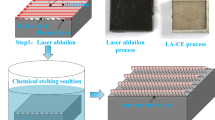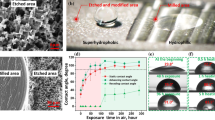Abstract
Surface-tension-confined microfluidic devices are platforms for manipulating 2D droplets based on patterned surfaces with special wettability. They have great potential for various applications, but are still in the early stages of development and face some challenges that need to be addressed. This study, inspired by the Wenzel and slippery transition of rose petal, develops a Patterned Oil-triggered Wenzel-slippery Surface (POWS) to examine the microfluidic devices. A laser-chemical composite method is established to fabricate POWSs, which take rose-petal-like microstructures as wettability pattern and a superamphiphobic surface as the background. The prepared POWSs switched between high adhesion superhydrophobic state and the slippery liquid-infused surface state through adding or removing the lubricant oil. In the high adhesion superhydrophobic state, the droplets can be sticked on the surface. In the slippery liquid-infused state, the droplet can slide along the wettability pattern as the designed route. A POWS-based droplet reactor is further constructed, on which, the droplets can be remotely controlled to move, mix and react, as required. Such a POWS, which manipulates droplets with surface tension controlled by the switchable wettability patterns, would be a promising candidate to construct multiple surface-tension-confined microfluidic devices. In addition, the fabrication technique and design principle proposed here may aid the development of various field related to the bio-inspired surfaces, such as water collection, desalination and high throughput analysis, etc.










Similar content being viewed by others
Data Availability
The data that support the findings of this study are not openly available due to some restrictions and are available from corresponding author upon reasonable request.
References
Feng, W., Ueda, E., & Levkin, P. A. (2018). Droplet microarrays: From surface patterning to high-throughput applications. Advanced Materials, 30, 1706111. https://doi.org/10.1002/adma.201706111.
Lifka, S., Hischen, F., Heitz, J., & Baumgartner, W. (2021). An optimised surface structure for passive, unidirectional fluid transport bioinspired by true bugs. Journal of Bionic Engineering, 18, 375–386. https://doi.org/10.1007/s42235-021-00076-x.
Hou, L. L., Liu, X. F., Ge, X. R., Hu, R. J., Cui, Z. M., Wang, N., & Zhao, Y. (2023). Designing of anisotropic gradient surfaces for directional liquid transport: Fundamentals, construction, and applications. The Innovation, 4, 100508. https://doi.org/10.1016/j.xinn.2023.100508.
Zhan, H., Xia, Y., Liu, Y., Sun, H., Ge, W., Feng, S., & Liu, Y. (2023). Sustainable droplet manipulation on ultrafast lubricant self-mediating photothermal slippery surfaces. Advanced Functional Materials, 33, 2211317. https://doi.org/10.1002/adfm.202211317
Jiao, L., Wu, Y., Hu, Y., Guo, Q., Wu, H., Yu, H., Deng, L., Li, D., & Li, L. (2023). Mosaic patterned surfaces toward generating hardly-volatile capsular droplet arrays for high‐precision droplet‐based storage and detection. Small (Weinheim An Der Bergstrasse, Germany), 19, 2206274. https://doi.org/10.1002/smll.202206274
Zhang, Y., Gan, Y., Zhang, L., & Chen, H. (2020). Surface-tension-confined channel with biomimetic microstructures for unidirectional liquid spreading. Micromachines, 11, 978. https://doi.org/10.3390/mi11110978.
You, I., Lee, T. G., Nam, Y. S., & Lee, H. (2014). Fabrication of a micro-omnifluidic device by omniphilic/omniphobic patterning on nanostructured surfaces. Acs Nano, 8, 9016–9024. https://doi.org/10.1021/nn502226v.
Zhang, Q., Wei, W., Wang, P., Zuo, L., Li, L., Xu, J., Xi, X., Gao, X., Ma, G., & Xie, H. (2017). Biomimetic magnetosomes as versatile artificial antigen-presenting cells to potentiate T-Cell-based anticancer therapy. Acs Nano, 11, 10724–10732. https://doi.org/10.1021/acsnano.7b04955.
Efremov, A. N., Stanganello, E., Welle, A., Scholpp, S., & Levkin, A. P. (2013). Micropatterned superhydrophobic structures for the simultaneous culture of multiple cell types and the study of cell-cell communication. Biomaterials, 34, 1757–1763. https://doi.org/10.1016/j.biomaterials.2012.11.034.
Lai, Y., Pan, F., Xu, C., Fuchs, H., & Chi, L. (2013). In situ surface-modification-induced superhydrophobic patterns with reversible wettability and adhesion. Advanced Materials, 25, 1682–1686. https://doi.org/10.1002/adma.201370077.
Khoo, H. S., & Tseng, F. G. (2009). Spontaneous high-speed transport of subnanoliter water droplet on gradient nanotextured surfaces. Applied Physics Letters, 95, 063108. https://doi.org/10.1063/1.3197574.
Ghosh, A., Ganguly, R., Schutzius, T. M., & Megaridis, C. M. (2014). Wettability patterning for high-rate, pumpless fluid transport on open, non-planar microfluidic platforms. Lab on a Chip, 14, 1538–1550. https://doi.org/10.1039/c3lc51406d.
Brinkmann, M., R. Lipowsky. (2002). Wetting morphologies on substrates with striped surface domains. Journal of Applied Physics, 92, 4296–4306. https://doi.org/10.1063/1.1506003.
Rosenfeld, A., Brehm, M., Welle, A., Trouillet, V., Heissler, S., Benz, M., & Levkin, P. A. (2019). Solid-phase combinatorial synthesis using microarrays of microcompartments with light-induced on-chip cell screening. Materials Today Bio, 3, 100022. https://doi.org/10.1016/j.mtbio.2019.100022.
Piret, G., Galopin, E., Coffinier, Y., Boukherroub, R., Legrand, D., & Slomianny, C. (2011). Culture of mammalian cells on patterned superhydrophilic/superhydrophobic silicon nanowire arrays. Soft Matter, 7, 8642. https://doi.org/10.1039/c1sm05838j.
Liu, H., Yang, Z., Meng, L., Sun, Y., Wang, J., Yang, L., Liu, J., & Tian, Z. (2014). Three-dimensional and time-ordered SERS hotspot matrix. Journal of the American Chemical Society, 136, 5332–5341. https://doi.org/10.1021/ja501951v.
Tseng, S. F., Hsiao, W. T., Chen, M. F., Huang, K., Hsiao, C., Lin, S. Y., & Chou, Y. S., C. P (2010). Surface wettability of silicon substrates enhanced by laser ablation. Applied Physics A, 101, 303–308. https://doi.org/10.1007/s00339-010-5821-y.
Küster, S., Pabst, K., Zenobi, M., & Dittrich, R., S (2015). Screening for protein phosphorylation using nanoscale reactions on microdroplet arrays. Angewandte Chemie International Edition, 54(5), 1671–1675. https://doi.org/10.1002/anie.201409440.
Küster, S., Pabst, K., Jefimovs, M., Zenobi, K., & Dittrich, R., S (2014). High-resolution droplet-based fractionation of nano-LC separations onto microarrays for MALDI-MS analysis. Analytical Chemistry, 86, 4848–4855. https://doi.org/10.1021/ac4041982.
Zhang, C. C., Wu, Z. Y., Zhang, X. M., Yue, Y. L., & Wang, J. (2018). Effect of feather elasticity of kingfisher wing on droplet impact dynamics. Journal of Bionic Engineering, 15, 731–740. https://doi.org/10.1007/s42235-018-0061-5.
Chen, Y. L., Guo, L., Cai, N. N., Sun, W. C., Yan, Y. Y., Li, D. G., Wang, H., & Xuan, R. (2023). Evaporation characteristics and morphological evolutions of fuel droplets after hitting different wettability surfaces. Journal of Bionic Engineering, 20, 734–747. https://doi.org/10.1007/s42235-022-00293-y.
Xie, H., & Huang, H. (2020). Gradient wetting transition from the wenzel to robust cassie-baxter states along nanopillared cicada wing and underlying mechanism. Journal of Bionic Engineering, 17, 1009–1018. https://doi.org/10.1007/s42235-020-0080-x.
Song, Y., Yu, Z., Liu, Y., Dong, L., & Ma, H. (2021). A hierarchical conical array with controlled adhesion and drop bounce ability for reducing residual non-newtonian liquids. Journal of Bionic Engineering, 18(3), 637–648. https://doi.org/10.1007/s42235-021-0042-y.
Parker, A., & Lawrence, R., C., R (2001). Water capture by a desert beetle. Nature, 414(6859), 33–34. https://doi.org/10.1038/35102108.
Park, K. C., Kim, P., Grinthal, A., He, N., Fox, D., Weaver, J. C., & Aizenberg, J. (2016). Condensation on slippery asymmetric bumps. Nature, 531, 78–82. https://doi.org/10.1038/nature16956.
Bae, W. G., Kim, H. N., Kim, D., Park, S. H., Jeong, H. E., & Suh, K. Y. (2014). 25th anniversary article: Scalable multiscale patterned structures inspired by nature: The role of hierarchy. Advanced Materials, 26(5), 675–700. https://doi.org/10.1002/adma.201303412.
Feng, L., Zhang, Y., Xi, J., Zhu, Y., Wang, N., Xia, F., & Jiang, L. (2008). Petal effect: A superhydrophobic state with high adhesive force. Langmuir: The ACS Journal of Surfaces and Colloids, 8, 24. https://doi.org/10.1021/la703821h.
Monojit, C., Justin, A. W., James, A., & Suresh, S., V, G (2019). Petal Effect: The wetting state of water on a rose petal. Advanced Materials Interfaces, 6(17), 1970110–1970110. https://doi.org/10.1002/admi.201970110.
Wong, T. S., Kang, S. H., Tang, S. K. Y., Smythe, E. J., Hatton, B. D., Grinthal, A., & Aizenberg, J. (2011). Bioinspired self-repairing slippery surfaces withpressure-stable omniphobicity. Nature, 477,(7365), 443–447. https://doi.org/10.1038/nature10447.
Mistura, G., & Pierno, M. (2017). Drop mobility on chemically heterogeneous and lubricant-impregnated surfaces. Advances in Physics: X, 2, 591–607. https://doi.org/10.1080/23746149.2017.1336940.
Sun, T., Wang, G., Feng, L., Liu, B. Q., Ma, Y. M., Jiang, L., & Zhu, D. B. (2004). Reversible switching between superhydrophilicity and superhydrophobicity. Angewandte Chemie (International Ed. In English), 43, 357–360. https://doi.org/10.1002/anie.200352565.
Gao, J., Liu, Y., Xu, H., Wang, Z., & Zhang, X. (2010). Biostructure-like surfaces with thermally responsive wettability prepared by temperature-induced phase separation micromolding. Langmuir the Acs Journal of Surfaces & Colloids, 26, 9673–9676. https://doi.org/10.1021/la100256b.
Ichimura, K., & Nakagawa, S. K., Masaru (2000). Light-driven motion of liquids on a photoresponsive surface. Science, 288, 1624–1626. https://doi.org/10.1126/science.288.5471.1624.
Kenanakis, G., Vernardou, D., & Katsarakis, N. (2012). Light-induced self-cleaning properties of ZnO nanowires grown at low temperatures. Applied Catalysis A General, 411, 7–14. https://doi.org/10.1016/j.apcata.2011.09.041.
Wang, G., Gong, S., Li, Z., Dou, L., Cai, W., & Mao, Y. (2016). Evolution of stress concentration and energy release before rock bursts: Two case studies from Xingan Coal mine, Hegang, China. Rock Mechanics and Rock Engineering, 49, 3393–3401. https://doi.org/10.1007/s00603-015-0892-x.
Tian, D., He, L., Zhang, N., Zheng, X., Dou, Y., Zhang, X., Guo, Z., & Jiang, L. (2016). Electric field and gradient microstructure for cooperative diving of directional motion of underwater oil droplets. Advanced Functional Materials, 26, 7986–7992. https://doi.org/10.1002/adfm.201601843.
Lahann, J., Mitragotri, S., Tran, T. N., Kaido, H., & Langer, R. (2003). A reversibly switching surface. Science, 299, 371–374. https://doi.org/10.1126/science.1078933.
Zhu, Y. Y., Dion, S. A., Xiao, R., & Wang, E. N. (2014). Real-time manipulation with magnetically tunable structures. Advanced Materials, 26, 6442–6446. https://doi.org/10.1002/adma.201401515.
Peng, Y., He, Y., Yang, S., Jiang, L., Ben, S., Cao, M., Liu, K., & Li, K. (2015). Magnetically induced fog harvesting via flexible conical arrays. Advanced Functional Materials, 25, 5967–5971. https://doi.org/10.1002/adfm.201502745.
Ge, P., Zhang, J., Liu, Y., Wang, S., Liu, W., Yu, N., Wu, Y., Zhang, J., & Yang, B. (2018). Smart anisotropic wetting surfaces with reversed pH-responsive wetting directions. Advanced Functional Materials, 28, 1802001. https://doi.org/10.1002/adfm.201802001.
Yu, X., Wang, Z., Jiang, Y., Feng, S., & Xi, Z. (2005). Reversible pH-responsive surface: From superhydrophobicity to superhydrophilicity. Advanced Materials, 17, 1289–1293. https://doi.org/10.1002/adma.200401646.
Cheng, Z., Zhang, D., Lv, T., Lai, H., Zhang, E., Kang, H., Wang, Y., Liu, P., Liu, Y., & Du, Y. (2018). Superhydrophobic shape memory polymer arrays with switchable isotropic/anisotropic wetting. Advanced Functional Materials, 28, 1705002. https://doi.org/10.1002/adfm.201705002.
Acknowledgements
This work was supported by Key Scientific and Technological Projects of Jilin Province (20220201026GX, 20220401083YY); Fundamental Research Funds for the Central Universities, Jilin University (2022-JCXK-15).
Funding
https://doi.org/10.13039/501100013061. Jilin Provincial Scientific and Technological Development Program 20220201026GX Prof Chunbao Liu. https://doi.org/10.13039/501100013061. Jilin Provincial Scientific and Technological Development Program 20220401083YY Prof Chunbao Liu. https://doi.org/10.13039/501100012226. Fundamental Research Funds for the Central Universities 2022-JCXK-15 Prof Chunbao Liu.
Author information
Authors and Affiliations
Contributions
W. Liu., L. Zhai., Z.Lin,. C. Liu.conceived the idea and supervised the study. W. Liu. and L. Zhai. carried out the experiments, numerical simulations and analyzed the experimental data. W. Liu., L. Zhai., and F. Guan. drafted the manuscript and all authors contributed to the writing of the manuscript.
Corresponding authors
Ethics declarations
Conflict of Interest
The authors declare no conflict of interest.
Additional information
Publisher’s Note
Springer Nature remains neutral with regard to jurisdictional claims in published maps and institutional affiliations.
Electronic Supplementary Material
Below is the link to the electronic supplementary material.
Rights and permissions
Springer Nature or its licensor (e.g. a society or other partner) holds exclusive rights to this article under a publishing agreement with the author(s) or other rightsholder(s); author self-archiving of the accepted manuscript version of this article is solely governed by the terms of such publishing agreement and applicable law.
About this article
Cite this article
Liu, W., Guan, F., Zhang, F. et al. Fabrication of Bio-inspired Superamphiphobic Aluminum Alloy Surface with Oil-triggered Wenzel-Slippery Transition via Femtosecond Laser. J Bionic Eng (2024). https://doi.org/10.1007/s42235-024-00514-6
Received:
Revised:
Accepted:
Published:
DOI: https://doi.org/10.1007/s42235-024-00514-6




